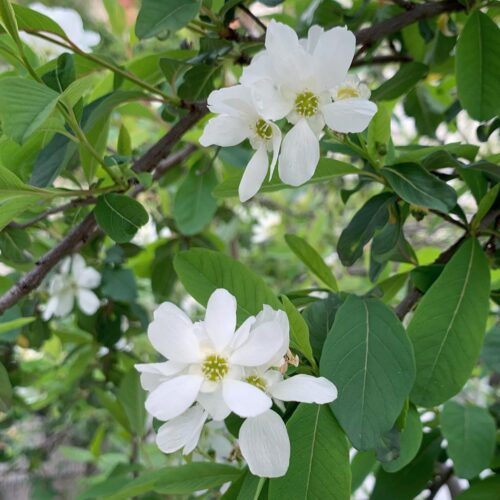Bring this beautiful shrub known as pearlbush to your garden. This low-maintenance plant makes a statement with five-petaled blooms.
Pearlbush or Exochorda is a deciduous shrub from Central Asia to China and Korea. It is popular for its arching growth and profuse, ornamental, saucer, or cup-shaped white flowers that appear in spike-like loose clusters. These blooms open from an abundance of buds that look like pearls.
Depending on the space, companion plants, and location, Pearlbush can grow to 10-15 feet tall and wide, and dwarf cultivars can attain a height of 4-6 feet.
Exochorda is closely related to spiraea. It boasts the most striking blooms in the spring. After this period, the plant blends into the background. To fully appreciate its springtime beauty, it’s important to place Exochorda in a prominent location. It works well in shrub borders or as a standalone specimen.
Botanical name: Exochorda racemosa
USDA Zones: 4-8
When to Plant Pearlbush

Plant pearlbush during the fall to ensure it is established by spring. These shrubs thrive in a well-drained area of the garden. Choose a permanent planting site, as pearlbush has a long taproot and is difficult to transplant.
Propagating Pearlbush
It is prohibited to propagate in patented cultivars. Common pearlbush can be grown from seed or cuttings. Root softwood cuttings during midsummer, take 3-6 inches long stem cutting and remove the bottom foliage. Plant the cuttings in potting mix or moist perlite. Cover the pot with a plastic dome. Maintain the soil moisture, but avoid overwatering. You can use a warming mat. If growing from seeds, stratify them first and plant them in a seedbed outdoors during fall.
Pearlbush Varieties
The available space will influence the variety you choose to grow. Common pearlbush shrubs might be too large for use as hedge plants. However, specially bred cultivars that grow 3 to 6 feet (1-2 meters) tall are better suited for hedging and borders. Consider trying these varieties:
- ‘Lotus Moon’ (Exochorda x macrantha ‘Bailmoon’): It can reach up to 4-5 feet tall in an upright form.’
- Snow Day ‘Surprise’ (Exochorda ‘Niagra’): This variety grows to 4-5 feet and offers large blooms.
- ‘The Bride’ (Exochorda x macrantha): It has a weeping growth habit and can reach up to 4 feet tall.
- Snow Day ‘Blizzard’ (Exochorda racemosa hybrid): This shrub displays large blooms in mound growth habit. It grows up to 5-6 feet tall.
Ideal Growing Conditions for Pearlbush
Light
Pearlbush performs well in full sun but can tolerate light shade. Ensure these shrubs receive at least six hours of sunlight each day. They handle heat and humidity well.
Soil
Use loamy, acidic, rich, well-draining soil for growing Pearlbush. This shrub prefers acidic soil but can handle average, clay, or alkaline soil.
NOTE: Before planting, increase the acidity level of the soil.
Water
Water the shrub frequently up to once a week. When it is established, it can handle drought.
Exochorda Racemosa Care
Fertilizer
Exochorda does not demand regular feeding; apply a bit of organic matter during planting for healthy soil.
Pruning
To maintain the size and shape of this shrub prune it just after flowering because it flowers on old wood. If overgrown, Exochorda can handle an intense rejuvenation pruning.
Discard damaged or dead wood whenever you notice. Prunning on an annual basis aids preserve the growth and manage the shape.
Pests and Diseases
Pearlbush is generally resistant to pests and diseases. However, if any issues arise, they are likely to involve aphids. Prevent aphid outbursts by beneficial predators such as ladybugs and lacewings.



